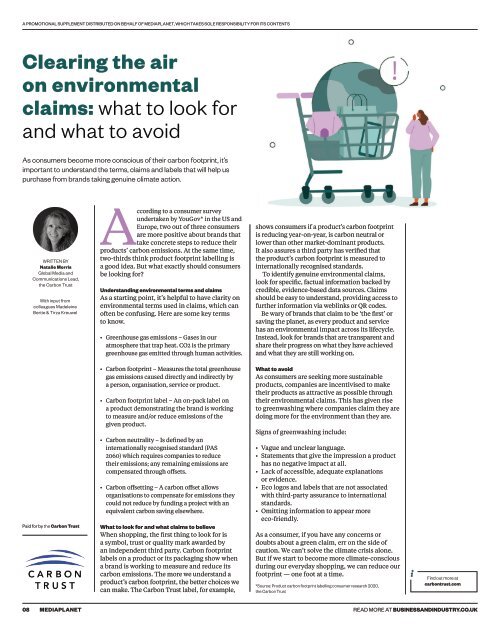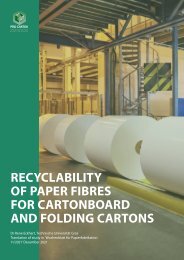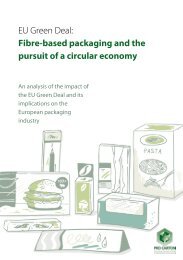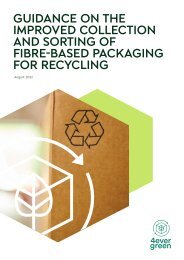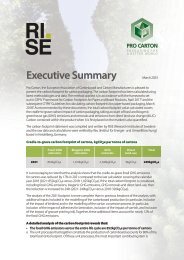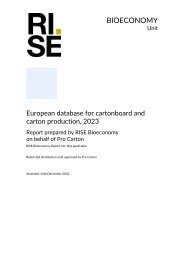2023 Sustainable Living Media Planet Supplement
You also want an ePaper? Increase the reach of your titles
YUMPU automatically turns print PDFs into web optimized ePapers that Google loves.
A PROMOTIONAL SUPPLEMENT DISTRIBUTED ON BEHALF OF MEDIAPLANET, WHICH TAKES SOLE RESPONSIBILITY FOR ITS CONTENTS<br />
Clearing the air<br />
on environmental<br />
claims: what to look for<br />
and what to avoid<br />
As consumers become more conscious of their carbon footprint, it’s<br />
important to understand the terms, claims and labels that will help us<br />
purchase from brands taking genuine climate action.<br />
WRITTEN BY<br />
Natalie Morris<br />
Global <strong>Media</strong> and<br />
Communications Lead,<br />
the Carbon Trust<br />
With input from<br />
colleagues Madeleine<br />
Bertie & Tirza Kreuwel<br />
According to a consumer survey<br />
undertaken by YouGov* in the US and<br />
Europe, two out of three consumers<br />
are more positive about brands that<br />
take concrete steps to reduce their<br />
products’ carbon emissions. At the same time,<br />
two-thirds think product footprint labelling is<br />
a good idea. But what exactly should consumers<br />
be looking for?<br />
Understanding environmental terms and claims<br />
As a starting point, it’s helpful to have clarity on<br />
environmental terms used in claims, which can<br />
often be confusing. Here are some key terms<br />
to know.<br />
• Greenhouse gas emissions – Gases in our<br />
atmosphere that trap heat. CO2 is the primary<br />
greenhouse gas emitted through human activities.<br />
shows consumers if a product’s carbon footprint<br />
is reducing year-on-year, is carbon neutral or<br />
lower than other market-dominant products.<br />
It also assures a third party has verified that<br />
the product’s carbon footprint is measured to<br />
internationally recognised standards.<br />
To identify genuine environmental claims,<br />
look for specific, factual information backed by<br />
credible, evidence-based data sources. Claims<br />
should be easy to understand, providing access to<br />
further information via weblinks or QR codes.<br />
Be wary of brands that claim to be ‘the first’ or<br />
saving the planet, as every product and service<br />
has an environmental impact across its lifecycle.<br />
Instead, look for brands that are transparent and<br />
share their progress on what they have achieved<br />
and what they are still working on.<br />
Paid for by the Carbon Trust<br />
• Carbon footprint – Measures the total greenhouse<br />
gas emissions caused directly and indirectly by<br />
a person, organisation, service or product.<br />
• Carbon footprint label – An on-pack label on<br />
a product demonstrating the brand is working<br />
to measure and/or reduce emissions of the<br />
given product.<br />
• Carbon neutrality – Is defined by an<br />
internationally recognised standard (PAS<br />
2060) which requires companies to reduce<br />
their emissions; any remaining emissions are<br />
compensated through offsets.<br />
• Carbon offsetting – A carbon offset allows<br />
organisations to compensate for emissions they<br />
could not reduce by funding a project with an<br />
equivalent carbon saving elsewhere.<br />
What to look for and what claims to believe<br />
When shopping, the first thing to look for is<br />
a symbol, trust or quality mark awarded by<br />
an independent third party. Carbon footprint<br />
labels on a product or its packaging show when<br />
a brand is working to measure and reduce its<br />
carbon emissions. The more we understand a<br />
product’s carbon footprint, the better choices we<br />
can make. The Carbon Trust label, for example,<br />
What to avoid<br />
As consumers are seeking more sustainable<br />
products, companies are incentivised to make<br />
their products as attractive as possible through<br />
their environmental claims. This has given rise<br />
to greenwashing where companies claim they are<br />
doing more for the environment than they are.<br />
Signs of greenwashing include:<br />
• Vague and unclear language.<br />
• Statements that give the impression a product<br />
has no negative impact at all.<br />
• Lack of accessible, adequate explanations<br />
or evidence.<br />
• Eco logos and labels that are not associated<br />
with third-party assurance to international<br />
standards.<br />
• Omitting information to appear more<br />
eco-friendly.<br />
As a consumer, if you have any concerns or<br />
doubts about a green claim, err on the side of<br />
caution. We can’t solve the climate crisis alone.<br />
But if we start to become more climate-conscious<br />
during our everyday shopping, we can reduce our<br />
footprint — one foot at a time.<br />
*Source: Product carbon footprint labelling consumer research 2020,<br />
the Carbon Trust<br />
Find out more at<br />
carbontrust.com<br />
08 MEDIAPLANET READ MORE AT BUSINESSANDINDUSTRY.CO.UK


